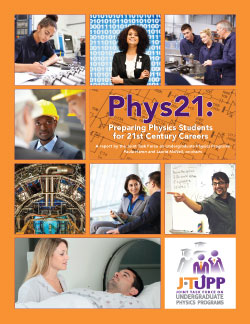Phys21: Preparing Physics Students for the 21st Century
The education landscape is changing, and the students who attend college are increasingly diverse. Many undergraduate physics programs, which in the past have served their students well as preparation for various careers, are finding that the needs of today’s employers are rapidly evolving. New occupations for physics graduates require skill sets that faculty members may not fully understand. Consequently, physics departments are often ill equipped to design a program of study that addresses the needs of these students and their future employers.
For this reason the American Physical Society (APS) and the American Association of Physics Teachers (AAPT) in 2014 assembled a group of academic and industrial physicists to form the Joint Task Force on Undergraduate Physics Programs (J-TUPP) to provide guidance to physics departments seeking to improve the career readiness of their graduates. The report of that task force, Phys21: Preparing Physics Students for 21st Century Careers, has now been released. It is intended to help physics faculty members to see beyond the “standard model” of preparing majors for physics graduate school and describes ways they can modify their programs to better prepare their graduates for the diverse careers that they will pursue, from engineer to entrepreneur to high school physics teacher to physics researcher.
It is the hope of the task force that industrial and applied physicists will engage in discussions of the recommendations of the report and find ways to partner with the physics education community to promote changes in physics programs that will help enhance the career readiness of their graduates. Doing so will help ensure the health of the physics profession into the future.
The full report as well as some supplementary material is available on the J-TUPP website.
Paula Heron and Laurie McNeil
J-TUPP Co-chairs

Opinions expressed represent the views of the individual authors and not the American Physical Society or author’s employers.
